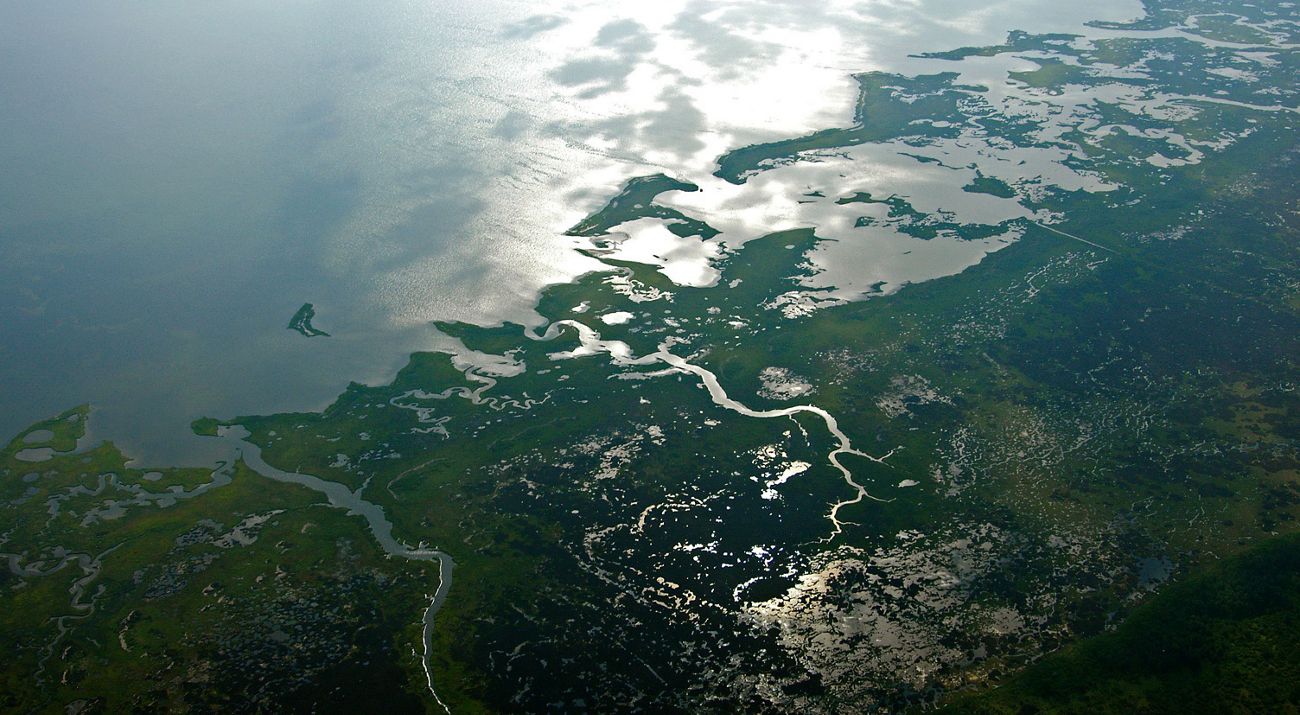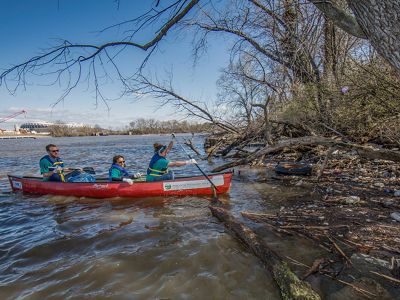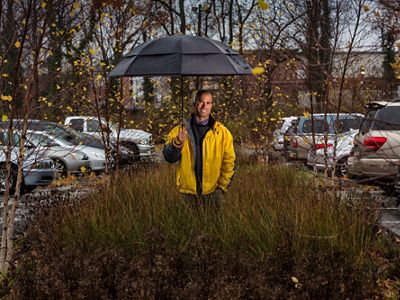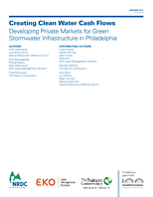Green Infrastructure for Cities

Green Infrastructure for Cities
Stormwater is the fastest growing source of freshwater pollution in the world, and a single quart of oil can create an oil slick that covers eight acres. In many urban areas, during times of heavy rain (or even light rain), sewer systems are quickly overwhelmed, and run off from the streets—a combination of rainwater, oil, grease, heavy metals, pesticides and other pollutants —combines with raw sewage and is discharged directly into our lakes, rivers, and oceans.
Hundreds of municipalities around the country are struggling to meet federally-mandated water quality goals designed to address this pollution. While billions of dollars will be spent to engineer “gray” solutions, green infrastructure—rain gardens, bioswales, and restored wetlands—not only offer cost savings but also generate co-benefits in the form of urban green space, improved air quality and community development.
Unlike gray infrastructure (such as treatment plants), which carries stormwater away from the source, green infrastructure relies on nature-based methods to retain stormwater directly at the point at which it falls. This green infrastructure allows water to be filtered naturally and slows its progress to sewers, lessening the chance that these systems will be overwhelmed.
NatureVest aims to help cities accelerate their use of green infrastructure to manage stormwater runoff by developing financing tools that attract private capital to support these projects, creating environmental and social benefits.
Relevant Reports
District Stormwater: Green Infrastructure in Washington, DC
Stormwater run-off is the biggest and fastest-growing source of water pollution in cities worldwide, including in Washington D.C. where up to three billion gallons of run-off and sewage flow into local rivers that course into the Chesapeake Bay estuary each year.
Because of this threat to local waterways, the nation’s capital is among more than 700 U.S. cities that are required by Federal regulation to invest in new infrastructure to manage stormwater runoff. The District has one of the country’s oldest sewage systems, which during moderate rain, sends untreated waste and pollution-laden run-off overflowing into the city streets and watershed. This severely degrades aquatic habitat and impacts industries within the Chesapeake Bay, North America’s most productive estuary.
A Collaboration Using Impact Investment Funds to Leverage Stormwater Solutions
In an effort to reduce the polluting effects of stormwater in the area, Prudential Financial invested $1.7 million towards a new collaboration between NatureVest and Encourage Capital called District Stormwater LLC (DS). The pilot project spearheads new strategies to support the country’s first Stormwater Retention Credit (SRC) trading launched by the District in 2013 that created the market to trade stormwater credits.
The new enterprise—jointly managed by NatureVest and Encourage Capital—will help finance the development of green infrastructure projects on properties across the city that measurably reduce stormwater run-off through proven distributed nature-based solutions. These investments will create credits to boost the SRC trading market.
Quote: Dr. Elizabeth Gray

“TNC is committed to demonstrating that cities can become more resilient with strong, nature-based solutions. Through this collaboration, we can show how innovative financing can bring such nature-based investments to Washington."
The SRC market enables developers, who are required to manage stormwater runoff on projects, to meet their mandated requirements by purchasing credits from offsite designs that reduce stormwater runoff, like rain gardens, green roofs, permeable pavement and other green infrastructure practices. This approach combines science, financing expertise and local relationship building to tailor solutions that will help make the SRC market function.
Investments in green infrastructure for stormwater retention can bring income to landowners and provide a host of valuable co-benefits, including expanded green space, reduced localized flooding and jobs to build and maintain green infrastructure sites. In particular, offsite trading creates opportunities for investments in vulnerable and economically-challenged communities where property values are lower. Green infrastructure can also ease economic burdens on small businesses by mitigating the flooding that results from major storms.

Looking Ahead: Scalable Innovation
This market and investment structure is replicable and scalable to other areas around the country—and specifically throughout the Chesapeake Watershed.
Next steps include identifying priority sites around the District to implement strategically placed green infrastructure. The projects are anticipated to benefit the city’s waterways, provide social benefits for local communities, and financial return for investors.

District Stormwater In the News
- Financing Solutions for Storm Water Run-Off (Environmental Finance)
- Turning Stormwater Runoff Into Everyone’s Business (CityLab)
- Collaboration to Reduce Storm Water Runoff in Washington, D.C. (Storm Water Solutions)
- District stormwater pollution effort gets help from “The Rock” (Chesapeake Bay Journal)
- FACT SHEET: $2 Billion in New Private Sector Investments to Protect Natural Resources to be Announced at White House Conservation Roundtable (The White House)
- TNC Leverages Expertise to Advance Resilience and Green Infrastructure (Climate Change Business Journal)
- Savings from Stormwater: How real estate developers can benefit from storm water credit purchases (Stormwater Solutions)
- Green Roofs, Built on Private Investment
